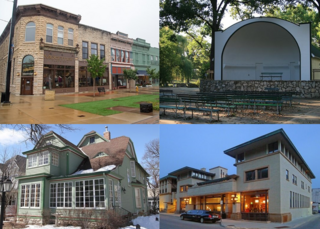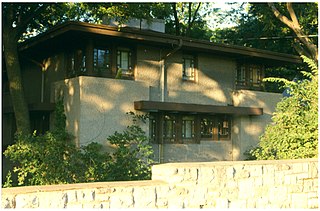
Mason City is a city and the county seat of Cerro Gordo County, Iowa, United States. The population was 27,338 in the 2020 census. Mason City is known for its musical heritage, high concentrations of renowned Prairie School style architecture, and a close connection with nearby Clear Lake.

Prairie School is a late 19th and early 20th-century architectural style, most common in the Midwestern United States. The style is usually marked by horizontal lines, flat or hipped roofs with broad overhanging eaves, windows grouped in horizontal bands, integration with the landscape, solid construction, craftsmanship, and discipline in the use of ornament. Horizontal lines were thought to evoke and relate to the wide, flat, treeless expanses of America's native prairie landscape.

The Dr. G.C. Stockman House was designed by Frank Lloyd Wright and built in 1908 for Dr. George C. and Eleanor Stockman in Mason City, Iowa. The home was originally located at 311 1st St. SE, but was moved to 530 1st St. NE to avoid demolition. It has been fully restored as a public museum and is listed on the National Register of Historic Places. It features numerous authentic period furnishings and reproduction pieces.

The Edward C. Roberts House is a historic building located on the east side of Davenport, Iowa, United States. It has been listed on the National Register of Historic Places since 1984.
The Chris Neessen House is a historic building located in Wellsburg, Iowa, United States. Christopher Neessen (1864–1944) immigrated from Germany in 1880 and became a farmer, land owner, and local banker. He hired Waterloo, Iowa architect Howard Bowman Burr to design this Prairie School house that was completed in 1916. The garage was built to the northeast of the house the following year. They were constructed by local builder Mylon Alexander Rohrbacher. The two-story brick house follows an irregular plan and measures 68 by 56 feet. It is located on an elevated corner lot. The house was listed on the National Register of Historic Places in 1984.

The A.J. Andrus Duplex, also known as the Paul Pritchard Duplex, is a historic building located in Mason City, Iowa, United States. The two story structure was completed in 1921 in the Prairie School style. Its most distinguishing feature is its C-shaped plan. The exterior is composed of brick on the first floor and stucco on the second floor. The duplex has a horizontal emphasis about it with a broad, overhanging hipped roof, and bands of windows. It was listed on the National Register of Historic Places in 1980.

The C.F. Franke House is a historic building located in Mason City, Iowa, United States. Built in 1916, the exterior of the two-story structure is covered with stucco. It utilizes the Mason City variant of the Prairie School style to stucco over corbelled masonry to form the wall panels for visual effect. Although the eaves on the second story were cut back almost flush with the walls, the house maintains its horizontal emphasis, including the grouping of the casement windows. It was listed on the National Register of Historic Places in 1980.

The E.R. Gibson House is a historic building located in Mason City, Iowa, United States. Built in 1912, this two-story stucco structure exhibits a strong Prairie School influence. It features a wide eaves, hip roof, a central chimney, and casement windows of leaded glass. The house was listed on the National Register of Historic Places in 1980.

The Lippert House is a historic building located in Mason City, Iowa, United States. Built in 1923, this two-story duplex is significant for its C-shaped plan and strong Prairie School influences. It features brick on the first floor, stucco on the second, wide eaves, broad hip roof, and a common utility wall. The house was listed on the National Register of Historic Places in 1980.
The F.M. Norris House, also known as the Patton House and the Gerard Photography Studio, was a historic building located in Mason City, Iowa, United States. Fred Magee Norris (1864-1938) served two terms as the mayor of the city. He was married to Elizabeth (Atkinson) Norris (1866-1933). They had Chris Rye build this Prairie School house for them. While Rye built some of Walter Burley Griffin's designs, it is possible that he designed this house himself. It featured a horizontal emphasis, wide eaves, broad hip roof, and stucco walls. The building was altered by Jerome J. Gerard (1913-2010) for his photography studio. In addition to his photographic work, he wrote for the magazine Popular Photography for 20 years. The house was listed on the National Register of Historic Places in 1980. It has subsequently been torn down.

The George Romey House, also known as the Bruce Girton House, is a historic building located in Mason City, Iowa, United States. George A. Romey was a local realtor who worked in partnership with William L. Patton. He had Fred Lippert design this Prairie School house, which was built by J.M. Felt & Company in 1920. Bruce Girton, the later owner, operated the family feed business. The two-story brick house features wide eaves, broad hip roof, and groups of casement windows. It was listed on the National Register of Historic Places in 1980.

The Charles Seney House, also known as the Van Heel Residence, is a historic building located in Mason City, Iowa, United States. This house is attributed to local architect Einar Broaten and built by Sivert Rivedal, a native of Norway. It utilizes the Mason City variant of the Prairie School style to stucco over corbelled masonry to form the wall panels for visual effect. The two-story house, completed in 1913, is capped with a hip roof. It was listed on the National Register of Historic Places in 1980.
The C. P. Shipley House was a historic building located in Mason City, Iowa, United States. Clinton Pardes Shipley (1851–1936) was a native of Baltimore County, Maryland. He married Margaret A. McMillin (1853–1940) in Mason City on November 17, 1875. The two-story Prairie School house, completed in 1913, had a stucco exterior, a broad hip roof and overhanging eaves. It was listed on the National Register of Historic Places in 1980. The house has subsequently been torn down. The Globe Gazette building is now on the property.

The Mier Wolf House is a historic building located in Mason City, Iowa, United States. Wolf was a prominent member of the local business community, operating a furniture store. Completed in 1909, this house is an early example of Prairie School architecture in Mason City. While its architect is unknown, it exhibits similarities to Frank Lloyd Wright's Mayan Period. The house features geometric wall decorations, truncated, stylized piers, and paired sculpted shapes on the heavy fascia of the broad overhanging hip roof. It was listed on the National Register of Historic Places in 1980.

The Curtis Yelland House is a historic building located in Mason City, Iowa, United States. Frank Lloyd Wright associate William Eugene Drummond designed this Prairie School style house, completed in 1910. The house features a strong horizontal emphasis, broad hip roofs, board-and-batten siding, stucco on the upper-story, and a centrally located fireplace and chimney round which the open plan interior revolves. The main entry is on the side of the house. The only entry to the front porch is from the living room. It was listed on the National Register of Historic Places in 1980. The house suffered a serious fire in 2008, and was almost torn down. However, developer Jeff Tierney bought the property and restored the house in 2010.

The Jewell Apartments is a historic building located in Mason City, Iowa, United States. Completed in 1917 by local contractor Fred Lippert, this apartment building is two C-shaped buildings joined together.

The Rock Crest–Rock Glen Historic District is a nationally recognized historic district located in Mason City, Iowa, United States. It was listed on the National Register of Historic Places in 1979. At the time of its nomination it contained 10 resources, which included eight contributing buildings, one contributing site, and one non-contributing building. All of the buildings are houses designed in the Prairie School style, and are a part of a planned development. Joshua Melson, a local developer, bought the property along Willow Creek between 1902 and 1908. Initially, there were only going to be 10 houses built, but the number grew to 16. While only half the houses planned were actually constructed, it is still the largest cluster of Prairie School houses in the country. The one non-contributing house is the 1959 McNider House, a Modern movement structure that was built where one of the planned houses was to be built, but never was. The architects who contributed to the district include Walter Burley Griffin, who provided the initial plan for the development; Barry Byrne, who took over from Griffin; Marion Mahony Griffin, Walter Griffin's wife and an architect in her own right; and Einar Broaten. Frank Lloyd Wright had a design that was never built here. The plans were used to build the Isabel Roberts House in River Forest, Illinois instead.

The James P. Newton House and Maid Cottage are historic buildings located in Sioux City, Iowa, United States. Newton was a prominent local businessman associated with Haskins Bros. & Co., whose principal product was soap. He was a traveling salesman with the company before he and his brothers bought the company in 1907. He succeeded his brother William as president in 1929. Newton had prominent Sioux City architect William L. Steele design this house, and it is one of his earliest works in the city. The 1½-story frame American Craftsman house and the single-story frame maid's house near the alley feature clapboard siding, porches with square columns, and low pitched hipped roofs with dormers. The bands of color and the wide eaves are elements from the Prairie School style for which Steele would become well known. The two houses were listed together on the National Register of Historic Places in 2000.
Mason City Engine House No. 2 is a historic building located in Mason City, Iowa, United States. As the city grew in population and expanded in size in the early 20th century, there was a need to add to the city's fire protection. A 1931 study recommended a new fire station on the south side. Seven years later, the New Deal-era Public Works Administration (PWA) approved funding for Mason City's second fire station and a new water tower. Property was acquired the same year. The local architectural firm of Hansen & Waggoner submitted plans for the new fire station in 1939, and local contractor Rye & Henkel won approval to build it. The PWA provided 45% of the funding with the remainder from local sources.
The W.L. and Winnie (Woodfield) Belfrage Farmstead Historic District is a nationally recognized historic district located south of Sergeant Bluff, Iowa, United States. It was listed on the National Register of Historic Places in 2017. At the time of its nomination it contained six resources, which included four contributing buildings and two non-contributing buildings. The four contributing buildings are the dairy barn (1910), farmhouse (1920), brooder house, and the chicken coop. The two no-contributing buildings are the cattle shed (1960) and the garage/utility building (2006).


















